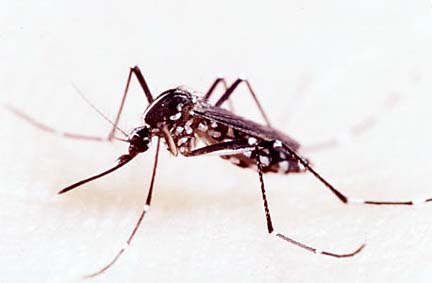


State strengthens THE STATE is beefing up its teams for a statewide response to the dengue fever outbreak on four islands, said Gary Gill, state deputy health director for environmental health.
response to
dengue fever cases
Cayetano calls widespread
infection highly unlikelyState Dengue Fever Resource Page
By Helen Altonn
haltonn@starbulletin.comThe Department of Health is working with counties to accelerate trash pickups and help the public remove mosquito-breeding sites, especially in wet, rural areas, Gill said.
The 21 cases confirmed by the federal Centers for Disease Control's Puerto Rico dengue laboratory are on Maui but several other cases on three islands tested positive in preliminary screening.
"We're doing everything we can and we've got the best minds in the world working on this thing," Health Director Anderson said today, adding that every area where a case is reported is being sprayed for mosquitoes.
In a worst-case scenario, the virus could cause serious illness for 200,000 people unless the mosquitoes are controlled, Anderson said.
In the best case, the state will be able to limit the problem to where it is now, he said.
"I'm optimistic that we will be able to do that, given the efforts that have been expended to date," Anderson said. "We caught problem early."
Gov. Ben Cayetano said today, "Worst case scenarios happen only if you do nothing about it. If you sit on your okoles and do nothing about it ... a worst case scenario becomes a self-fulfilling prophecy. It's a scenario that is highly unlikely to happen."
Dengue fever is being transmitted here by Asian tiger mosquitoes that lay eggs in water. They pass on the virus by biting someone after biting an infected person.
In most places of the world with the disease, about 60 percent of the population has become infected and about 20 percent of those become ill, Anderson said.
Hawaii locations with confirmed or suspected cases are being identified in hopes people will be more vigilant about cleaning mosquito-breeding areas off their property, he said.
The 30 cases with confirmed or preliminary evidence of dengue infection are located as follows, on Maui: Haiku, 3; Hana area, 22; Lahaina, 1; Wailuku , 2; on Kauai, one case in Anahola, and on Oahu, one in Kaaawa.
Ninety additional suspected cases are under investigation and 43 people are being followed up on but don't meet the clinical criteria for dengue at this time.
Home areas of clinical cases include on Maui: Haiku, 9; Haliimaile, 1; Hana area, 40; Huelo, 2; Kahului, 2; Kihei, 7; Kula, 1; Lahaina, 4; Makawao, 1; Pukalani, 3; Wailuku, 9,
On Kauai, one in Kalaheo. On Oahu, one case each is suspected in Honolulu, Laie, Wahiawa and Waikele, and two in Kaneohe. On the Big Island, Hilo and Mountain View each has one case and there are two in Kailua-Kona.
Gill said all areas are being sprayed. "We're using a spray that is akin to a household can of Raid, so that it will knock down any mosquito in the air at any given time. But the long-term solution is to make sure they don't have areas to breed by removing any standing water on property."
Epidemiologists and health researchers are watching the situation with great interest. "When I first heard rumors that there were dengue cases on Maui, I said, 'Nah, not likely,'" said Dr. David Morens, an internationally known dengue fever researcher and former University of Hawaii epidemiology professor. He left UH in 1998 for a special position with the National Institutes of Health in Bethesda, Md.
In a phone interview, Morens noted that Hawaii once had two of the world's leading research groups on the dengue virus at the UH and Leahi Hospital.
When the federal government withdrew funding for the program, UH didn't replace it, he said.
Morens also noted that of the four types of dengue virus, two were identified by Albert Sabin, discoverer of the polio vaccine.
Sabin was in Hawaii in the Army during World War II when he identified DEN1, known as the Hawaii strain. He was on the mainland when a blood sample was sent to him from an Army pilot who contracted the virus in Papua New Guinea and came through Hawaii. It is DEN2, the New Guinea C. strain.
The type infecting island residents so far is DEN1, a rather mild form of the virus.
Hawaii never has had dengue hemorrhagic fever, one of the major causes of disease fatality around the world, especially in Southeast Asia, Morens said.
However, there has been a trend over 50 years for increasing dengue epidemics across the Pacific and Southeast Asia, and more frequent dengue hemorrhagic fever, Morens said.
He said state epidemiologist Paul Effler, a former student of his, is doing the right things to prevent a dengue epidemic.
"He is really very, very good, one of the smartest state health officers in the country," Morens said.
William E. Woods, past president of the UH School of Public Health alumnae, cites many concerns about the dengue outbreak, saying the Health Department has not acted fast enough, and he is "clearly convinced that the problem is way beyond the Hawaii-based decision-makers to answer."
However, UH epidemiologists DeWolfe Miller and Alan Katz praised the Health Department epidemiologists and their response to the virus.
"Under the circumstances here, most people are going to recover rapidly and completely," Miller said. "We have a very good epidemiology team at DOH ... and they're on it; they're all over it."
The Associated Press contributed to this report